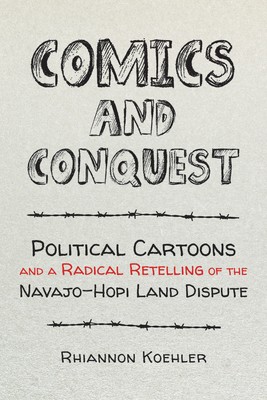
- We will send in 10–14 business days.
- Author: Rhiannon Koehler
- Publisher: Johns Hopkins University Press
- ISBN-10: 1421447428
- ISBN-13: 9781421447421
- Format: 15.2 x 22.9 x 1.8 cm, kieti viršeliai
- Language: English
- SAVE -10% with code: EXTRA
Reviews
Description
The untold story of Navajo and Hopi resistance and solidarity in the face of forced removal by the US government, as documented by tribal editorial cartoons.
For generations, US politicians and energy companies attempted to gain access to the coal and uranium in the Four Corners region, where Arizona, New Mexico, Colorado, and Utah meet. However, the land on which they found billions of tons of high-grade, low-sulfur coal in 1909 was reserved for Navajo (Diné) and Hopi peoples and not accessible to extractive enterprise. Despite Diné and Hopi protests, US officials gained access to the coal-rich land on Black Mesa in Arizona by purposely fabricating and fueling conflict between the Diné and the Hopi.
In Comics and Conquest, historian Rhiannon Koehler documents the untold story of this conflict through an engaging analysis of historical Navajo and Hopi editorial cartoons. Despite the false narrative that the conflict was driven by inter-tribal animosity and that the subsequent forced removals of thousands of Indigenous peoples were part of a plan to keep the peace, the cartoons that Koehler shares reveal a rich history of artistic activism and Hopi-Diné solidarity against this land grab. The content and claims featured in political cartoons published in the tribal newspapers Qua'Toqti and the Navajo Times in the late 1960s and early 1970s were some of the most critical tools for both coping with the threats of industry and exposing the history of exploitation as it carries on into the present.
The conflict, popularly known as the Navajo-Hopi Land Dispute, was presented in mainstream media as an egregious threat to US interests. Acutely aware of their land's value and the minerals and other resources on it, Diné and Hopi political cartoonists used their medium to assert their protest and agency, identify the true instigators of the dispute, and expose and counter the myth that the conflict had inter-tribal origins. Koehler shows how tribal activism and media ultimately resulted in international recognition of the harms perpetrated by the federal government on Diné and Hopi soil.
EXTRA 10 % discount with code: EXTRA
The promotion ends in 21d.13:52:29
The discount code is valid when purchasing from 10 €. Discounts do not stack.
- Author: Rhiannon Koehler
- Publisher: Johns Hopkins University Press
- ISBN-10: 1421447428
- ISBN-13: 9781421447421
- Format: 15.2 x 22.9 x 1.8 cm, kieti viršeliai
- Language: English English
The untold story of Navajo and Hopi resistance and solidarity in the face of forced removal by the US government, as documented by tribal editorial cartoons.
For generations, US politicians and energy companies attempted to gain access to the coal and uranium in the Four Corners region, where Arizona, New Mexico, Colorado, and Utah meet. However, the land on which they found billions of tons of high-grade, low-sulfur coal in 1909 was reserved for Navajo (Diné) and Hopi peoples and not accessible to extractive enterprise. Despite Diné and Hopi protests, US officials gained access to the coal-rich land on Black Mesa in Arizona by purposely fabricating and fueling conflict between the Diné and the Hopi.
In Comics and Conquest, historian Rhiannon Koehler documents the untold story of this conflict through an engaging analysis of historical Navajo and Hopi editorial cartoons. Despite the false narrative that the conflict was driven by inter-tribal animosity and that the subsequent forced removals of thousands of Indigenous peoples were part of a plan to keep the peace, the cartoons that Koehler shares reveal a rich history of artistic activism and Hopi-Diné solidarity against this land grab. The content and claims featured in political cartoons published in the tribal newspapers Qua'Toqti and the Navajo Times in the late 1960s and early 1970s were some of the most critical tools for both coping with the threats of industry and exposing the history of exploitation as it carries on into the present.
The conflict, popularly known as the Navajo-Hopi Land Dispute, was presented in mainstream media as an egregious threat to US interests. Acutely aware of their land's value and the minerals and other resources on it, Diné and Hopi political cartoonists used their medium to assert their protest and agency, identify the true instigators of the dispute, and expose and counter the myth that the conflict had inter-tribal origins. Koehler shows how tribal activism and media ultimately resulted in international recognition of the harms perpetrated by the federal government on Diné and Hopi soil.


Reviews